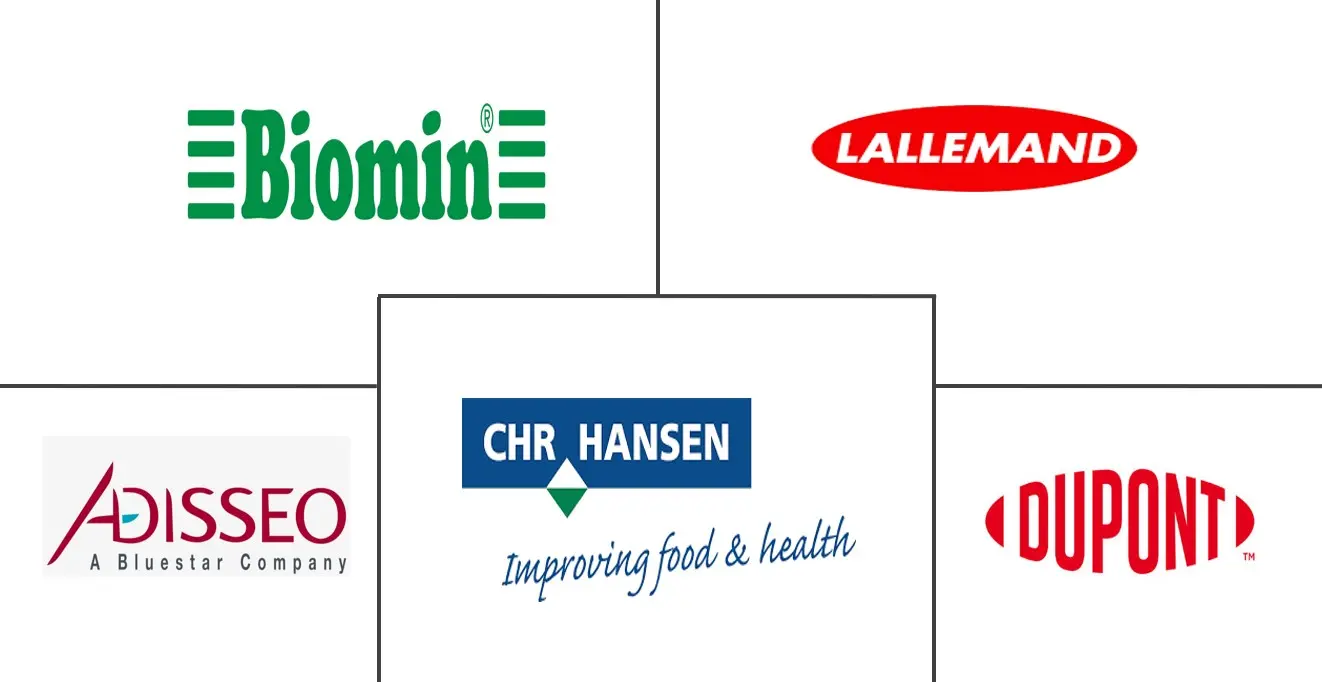Market Size of Middle East Feed Probiotics Industry

| Study Period | 2019 - 2029 |
| Base Year For Estimation | 2023 |
| Forecast Data Period | 2024 - 2029 |
| Historical Data Period | 2019 - 2022 |
| CAGR | 6.80 % |
| Market Concentration | Low |
Major Players
*Disclaimer: Major Players sorted in no particular order |
ME Feed Probiotics Market Analysis
The Middle-East feed probiotics market is projected to witness a CAGR of 6.8% during the forecast period (2021 - 2026). The animal feed industry had badly affected by the COVID-19 pandemic, which compelled farmers to stock their animal feed supplies, including additives such as probiotics. This had led to a spike in demand for animal feed additives when the lockdown was initially imposed.
Probiotics are widely used in farm livestock, companion animals, and aquaculture, as they are principally associated with reducing clinical disease and increasing growth rates. Therefore, as consumers are becoming more health-conscious, livestock producers are shifting toward sustainable livestock farming techniques, which may drive the market for probiotics.
The regional feed probiotics market is segmented based on product type and animal type. By product type, lactobacilli form the majority of the market share in feed probiotics. By animal type, ruminants and poultry are the two major consuming segments of probiotics in the region. Aquaculture is a key source of fish in Egypt. Probiotics, which control pathogens through various mechanisms, are increasingly being used in feed in aquaculture in Egypt. As a fast-growing sector, the need for efficient production with minimal harm to the aquatic environment forced producers to seek healthier alternatives. Therefore, the probiotics market is expected to gain momentum with the increasing animal-based products' trade activity in the region.
ME Feed Probiotics Industry Segmentation
Feed probiotics refer to the probiotics (beneficial micro-organisms) incorporated into base mixes and compound forms, with premix producers, farmers, compound feed producers, and base mix and concentrate producers as end consumers. The scope of the report does not include premix-based probiotics. The market is segmented by type (lactobacilli, bifidobacteria, and other types), application (ruminant, poultry, swine, aquaculture, and other applications), and geography (Saudi Arabia, United Arab Emirates, Egypt, Turkey, Jordan, and Rest of Middle East).
| By Type | |
| Lactobacilli | |
| Bifidobacteria | |
| Other Types |
| By Application | |
| Ruminants | |
| Poultry | |
| Swine | |
| Aquaculture | |
| Other Applications |
| By Geography | |
| Saudi Arabia | |
| Egypt | |
| United Arab Emirates | |
| Turkey | |
| Jordan | |
| Rest of Middle East |
Middle East Feed Probiotics Market Size Summary
The Middle East feed probiotics market is experiencing significant growth, driven by the increasing demand for sustainable livestock farming and the rising health consciousness among consumers. Probiotics are becoming essential in the animal feed industry, particularly for farm livestock, companion animals, and aquaculture, as they help reduce clinical diseases and enhance growth rates. The market is segmented by product type, with lactobacilli holding a substantial share, and by animal type, where ruminants and poultry are the primary consumers. The aquaculture sector in Egypt is notably adopting probiotics to improve fish health and production efficiency, aligning with the region's growing trade in animal-based products. The demand for meat, especially in countries like the United Arab Emirates, is fueling the need for feed probiotics to ensure the sustainable production of high-quality animal proteins.
Saudi Arabia leads the Middle Eastern feed probiotics market, supported by its substantial livestock population and the adoption of compound feed enriched with probiotics. The country's focus on improving animal health standards and reducing antibiotic use in meat is creating opportunities for probiotic ventures. Major players in the market, such as Adisseo, Dupont, Biomin, and Chr. Hansen Holding AS, are expanding their operations and production capacities to meet the growing demand. The market's fragmentation indicates a competitive landscape, with companies actively seeking to enhance their presence in the region. The collaboration between global leaders like Adisseo and Novozymes to launch probiotics for poultry further underscores the market's potential for growth and innovation.
Middle East Feed Probiotics Market Size - Table of Contents
-
1. MARKET DYNAMICS
-
1.1 Market Overview
-
1.2 Market Drivers
-
1.3 Market Restraints
-
1.4 Industry Attractiveness - Porter's Five Forces Analysis
-
1.4.1 Bargaining Power of Suppliers
-
1.4.2 Bargaining Power of Consumers
-
1.4.3 Threat of New Entrants
-
1.4.4 Threat of Substitute Products
-
1.4.5 Intensity of Competitive Rivelry
-
-
-
2. MARKET SEGMENTATION
-
2.1 By Type
-
2.1.1 Lactobacilli
-
2.1.2 Bifidobacteria
-
2.1.3 Other Types
-
-
2.2 By Application
-
2.2.1 Ruminants
-
2.2.2 Poultry
-
2.2.3 Swine
-
2.2.4 Aquaculture
-
2.2.5 Other Applications
-
-
2.3 By Geography
-
2.3.1 Saudi Arabia
-
2.3.2 Egypt
-
2.3.3 United Arab Emirates
-
2.3.4 Turkey
-
2.3.5 Jordan
-
2.3.6 Rest of Middle East
-
-
Middle East Feed Probiotics Market Size FAQs
What is the current Middle East Feed Probiotics Market size?
The Middle East Feed Probiotics Market is projected to register a CAGR of 6.80% during the forecast period (2024-2029)
Who are the key players in Middle East Feed Probiotics Market?
Dupont, Lallemand Inc. , Biomin, Adisseo and Chr. Hansen Holding AS are the major companies operating in the Middle East Feed Probiotics Market.

